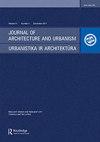哈里斯和艾森曼的观点截然不同,在将审美印象带回建筑环境方面,他们对建筑文化有何贡献?
IF 0.6
0 ARCHITECTURE
引用次数: 0
摘要
在现代主义时代,人们看到艺术的自然符号--通过审美元素表达出来--被交流的语言符号所取代。这种取代迫使后现代主义者解构现代主义的概念,从表面上恢复象征性艺术的概念,重振艺术的意义及其在建筑环境中的凝聚力。然而,振兴过程似乎并没有不引起学术界的质疑。审美冲动仅仅来自建筑形式的结构精神吗?仅仅是美学深深植根于建筑形式的特性吗?审美与社会环境和经济生活无关吗?美学可以孤立存在吗?美学可以是功能性的副产品而非产品本身吗?本文利用哈里斯和艾森曼的作品,绘制了一幅探讨这些问题的评论草图。许多其他属性,如美学生产、美学生成和环境美学,以及它们在艺术鉴赏中的作用,都确保了在讨论中的地位。结论似乎警告人们,在后现代及以后的时代,社会共存对建筑形式美学定义的影响脱离了现实--回避了社会结构中不同层次的存在及其相互之间的关系--很少有助于产生任何未来主义的愿景,反而会导致建筑研究与实践之间的思想和观念的混乱。本文章由计算机程序翻译,如有差异,请以英文原文为准。
WHAT DO THE CONTRASTING VIEWS OF HARRIES AND EISENMAN ADD TO ARCHITECTURAL CULTURE IN BRINGING AESTHETIC IMPRESSIONS BACK TO THE BUILT ENVIRONMENT?
In the era of modernism, the natural symbols of art – expressed through aesthetic elements – have been seen replaced by the verbal notations of communication. The replacement forced the postmodernists to deconstruct the concept of modernism to bring back the notion of symbolic art superficially and to revitalize the meaning of art and its cohesive presence in the built environment. The revitalization process, however, does not seem to have gone without raising questions in the academic community. Does the aesthetic impulse come from the structural spirit of a built form alone? Is just aesthetics deeply rooted in built-form identity? Is aesthetics not associated with the social environment and economic living? Can aesthetics exist in isolation? Can aesthetics be more of a by-product of functionality than the product itself? Using the works of Harries and Eisenman, the paper develops a review sketch exploring these questions. Many other attributes, such as aesthetics production, aesthetics generation, and environmental aesthetics, and their roles in art appreciation have ensured positions in the discussion. The conclusions seem to warn that the influence of social co-existence in defining built-form aesthetics in the postmodern era and later, divorced from reality – avoiding the presence of the different layers in the social fabric and their relationships among themselves – seldom helps to produce any futuristic vision but invites chaos in thoughts and perceptions crossing over between studies and practices in architecture.
求助全文
通过发布文献求助,成功后即可免费获取论文全文。
去求助
来源期刊

Journal of Architecture and Urbanism
ARCHITECTURE-
CiteScore
1.30
自引率
14.30%
发文量
12
审稿时长
15 weeks
期刊介绍:
The Journal of Architecture and Urbanism publishes original research on all aspects of urban architecture.
 求助内容:
求助内容: 应助结果提醒方式:
应助结果提醒方式:


